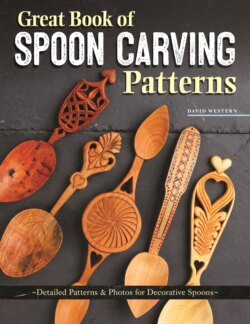Читать книгу Notes from a Swedish Kitchen - David Western - Страница 12
На сайте Литреса книга снята с продажи.
ОглавлениеBasic Cuts
Like most types of carving, spoon carving is a subtractive art—you remove all of the material that isn’t part of your vision for the final piece. Most carvers use four basic cuts to remove excess wood: the stop cut, the push cut, the paring cut, and the V-shaped cut. Master these four basic types of cuts and you’ll be ready to tackle a multitude of projects.
STOP CUT
As the name suggests, the stop cut is used to create a hard line at the end of another cut. Your hand position depends on the placement of the cut you need to make. Regardless of your hand position, simply cut straight into the wood to create a stop cut. Make a stop cut first to prevent a consecutive cut from extending beyond the intended area. Make a stop cut second to free a chip of wood remaining from a primary cut.
PUSH CUT
For the push cut, hold the wood in one hand. Hold the knife in your other hand with the thumb on the back of the blade. Push the knife through the wood, away from your body. This type of cut is also called the straightaway cut. For additional control or power, place the thumb of the wood-holding hand on top of the thumb on the blade, and use the wood-holding thumb as a pivot as you rotate the wrist of your knife-holding hand. This maneuver is often called the thumb-pushing cut or lever cut.
PARING CUT
The paring cut gives you a great deal of control but requires you to cut toward your thumb. Wear a thumb protector or be aware of the knife position at all times, especially if it slips beyond the anticipated stopping point. To perform the paring cut, which is also called a draw cut, hold the wood in one hand. Hold the knife in the other hand with four fingers. The cutting edge points toward your thumb. Rest the thumb of your knife-holding hand on the wood behind the area you want to carve. Extend the thumb as much as possible. Close your hand, pulling the knife toward your thumb, to slice through the wood. This is the same action used to peel (or pare) potatoes.
V-SHAPED CUT
To make a V-shaped cut, hold a knife the same way you do when making a paring cut. Anchor the thumb of the knife hand against the wood and cut in at an angle with the tip of the knife. Rotate the wood, anchor your thumb on the other side of the cut, and cut in at an angle, running beside the first cut. Angle the two cuts so the bottom or deepest part of each cut meets in the center. This creates a V-shaped groove. Use the center of the cutting edge to make intersecting angled cuts on the corner of a blank, creating V-shaped notches.
